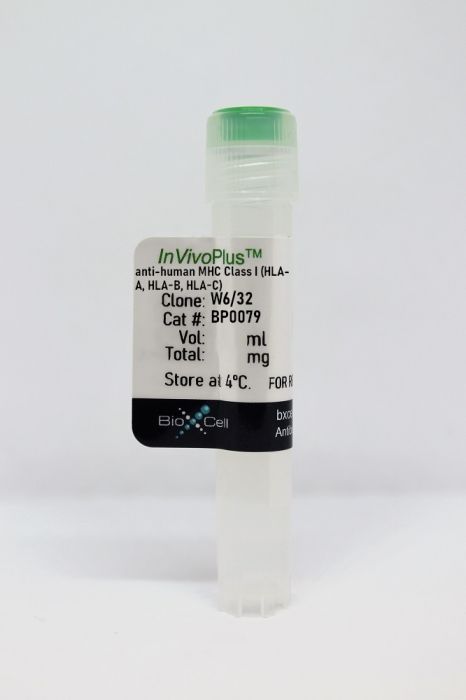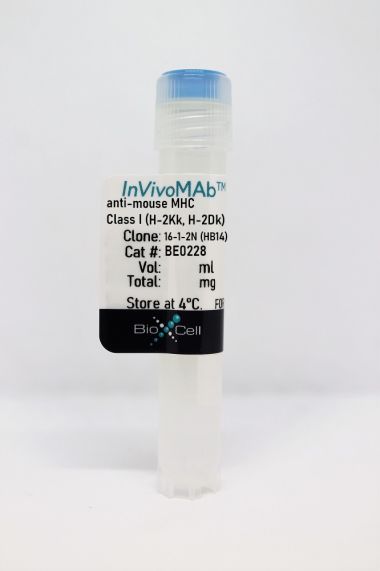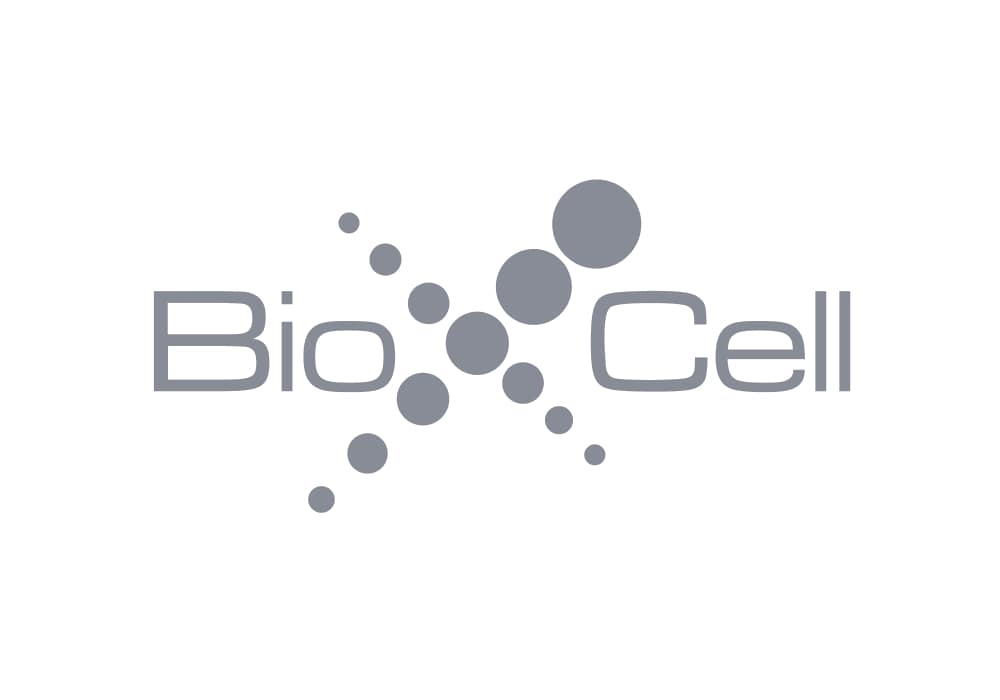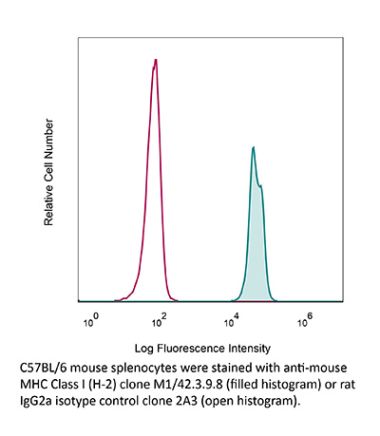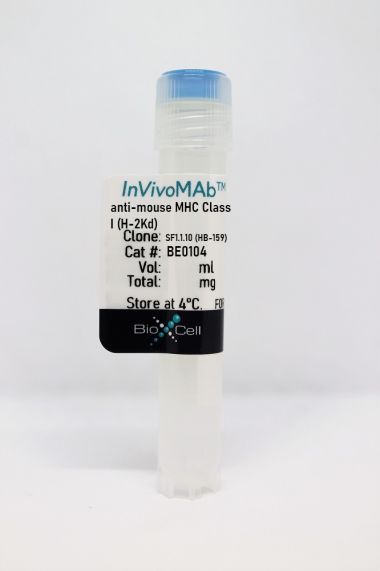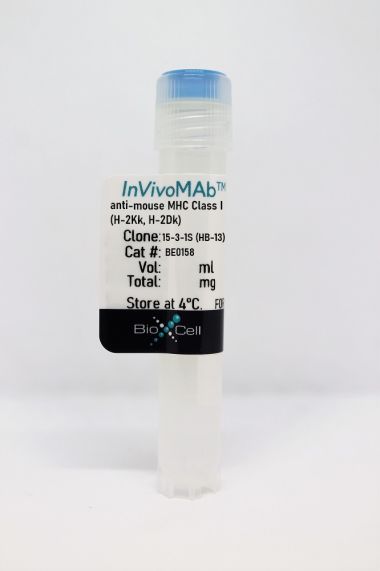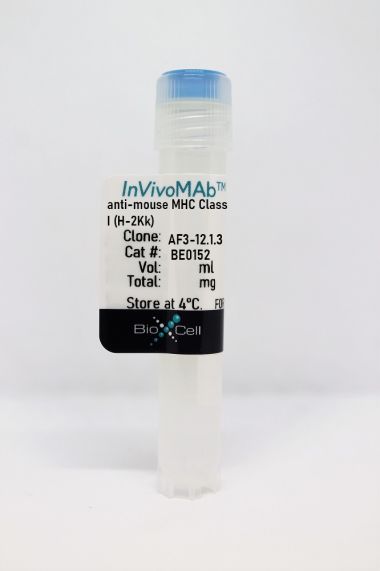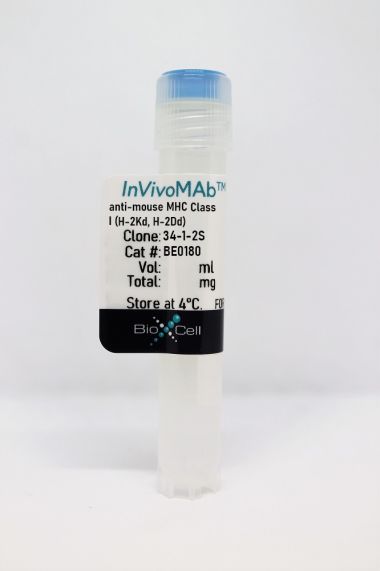InVivoPlus anti-human MHC Class I (HLA-A, HLA-B, HLA-C)
Product Details
The W6/32 monoclonal antibody reacts with the human major histocompatibility complex (MHC) class I, HLA-A, B, and C. All human nucleated cell express MHC class I antigens associated with β2-microglobulin. MHC class I plays a central role in cell-mediated immune responses and tumor surveillance.Specifications
| Isotype | Mouse IgG2a, κ |
|---|---|
| Recommended Isotype Control(s) | InVivoPlus mouse IgG2a isotype control, unknown specificity |
| Recommended Dilution Buffer | InVivoPure pH 6.5 Dilution Buffer |
| Conjugation | This product is unconjugated. Conjugation is available via our Antibody Conjugation Services. |
| Immunogen | Human tonsil cell membrane |
| Reported Applications | Functional assays |
| Formulation |
PBS, pH 6.5 Contains no stabilizers or preservatives |
| Endotoxin* |
<1EU/mg (<0.001EU/μg) Determined by LAL gel clotting assay |
| Aggregation* |
<5% Determined by SEC |
| Purity |
>95% Determined by SDS-PAGE |
| Sterility | 0.2 µm filtration |
| Production | Purified from cell culture supernatant in an animal-free facility |
| Purification | Protein G |
| RRID | AB_1107730 |
| Molecular Weight | 150 kDa |
| Murine Pathogen Tests* |
Ectromelia/Mousepox Virus: Negative Hantavirus: Negative K Virus: Negative Lactate Dehydrogenase-Elevating Virus: Negative Lymphocytic Choriomeningitis virus: Negative Mouse Adenovirus: Negative Mouse Cytomegalovirus: Negative Mouse Hepatitis Virus: Negative Mouse Minute Virus: Negative Mouse Norovirus: Negative Mouse Parvovirus: Negative Mouse Rotavirus: Negative Mycoplasma Pulmonis: Negative Pneumonia Virus of Mice: Negative Polyoma Virus: Negative Reovirus Screen: Negative Sendai Virus: Negative Theiler’s Murine Encephalomyelitis: Negative |
| Storage | The antibody solution should be stored at the stock concentration at 4°C. Do not freeze. |
Additional Formats
Recommended Products
Functional Assays
Valenzuela, N. M., et al. (2013). "Blockade of p-selectin is sufficient to reduce MHC I antibody-elicited monocyte recruitment in vitro and in vivo" Am J Transplant 13(2): 299-311. PubMed
Donor-specific HLA antibodies significantly lower allograft survival, but as yet there are no satisfactory therapies for prevention of antibody-mediated rejection. Intracapillary macrophage infiltration is a hallmark of antibody-mediated rejection, and macrophages are important in both acute and chronic rejection. The purpose of this study was to investigate the Fc-independent effect of HLA I antibodies on endothelial cell activation, leading to monocyte recruitment. We used an in vitro model to assess monocyte binding to endothelial cells in response to HLA I antibodies. We confirmed our results in a mouse model of antibody-mediated rejection, in which B6.RAG1(-/-) recipients of BALB/c cardiac allografts were passively transferred with donor-specific MHC I antibodies. Our findings demonstrate that HLA I antibodies rapidly increase intracellular calcium and endothelial presentation of P-selectin, which supports monocyte binding. In the experimental model, donor-specific MHC I antibodies significantly increased macrophage accumulation in the allograft. Concurrent administration of rPSGL-1-Ig abolished antibody-induced monocyte infiltration in the allograft, but had little effect on antibody-induced endothelial injury. Our data suggest that antagonism of P-selectin may ameliorate accumulation of macrophages in the allograft during antibody-mediated rejection.
Functional Assays
Valenzuela, N. M., et al. (2013). "HLA class I antibodies trigger increased adherence of monocytes to endothelial cells by eliciting an increase in endothelial P-selectin and, depending on subclass, by engaging FcgammaRs" J Immunol 190(12): 6635-6650. PubMed
Ab-mediated rejection (AMR) of solid organ transplants is characterized by intragraft macrophages. It is incompletely understood how donor-specific Ab binding to graft endothelium promotes monocyte adhesion, and what, if any, contribution is made by the Fc region of the Ab. We investigated the mechanisms underlying monocyte recruitment by HLA class I (HLA I) Ab-activated endothelium. We used a panel of murine mAbs of different subclasses to crosslink HLA I on human aortic, venous, and microvascular endothelial cells and measured the binding of human monocytic cell lines and peripheral blood monocytes. Both anti-HLA I murine (m)IgG1 and mIgG2a induced endothelial P-selectin, which was required for monocyte adhesion to endothelium irrespective of subclass. mIgG2a but not mIgG1 could bind human FcgammaRs. Accordingly, HLA I mIgG2a but not mIgG1 treatment of endothelial cells significantly augmented recruitment, predominantly through FcgammaRI, and, to a lesser extent, FcgammaRIIa. Moreover, HLA I mIgG2a promoted firm adhesion of monocytes to ICAM-1 through Mac-1, which may explain the prominence of monocytes during AMR. We confirmed these observations using human HLA allele-specific mAbs and IgG purified from transplant patient sera. HLA I Abs universally elicit endothelial exocytosis leading to monocyte adherence, implying that P-selectin is a putative therapeutic target to prevent macrophage infiltration during AMR. Importantly, the subclass of donor-specific Ab may influence its pathogenesis. These results imply that human IgG1 and human IgG3 should have a greater capacity to trigger monocyte infiltration into the graft than IgG2 or IgG4 due to enhancement by FcgammaR interactions.

